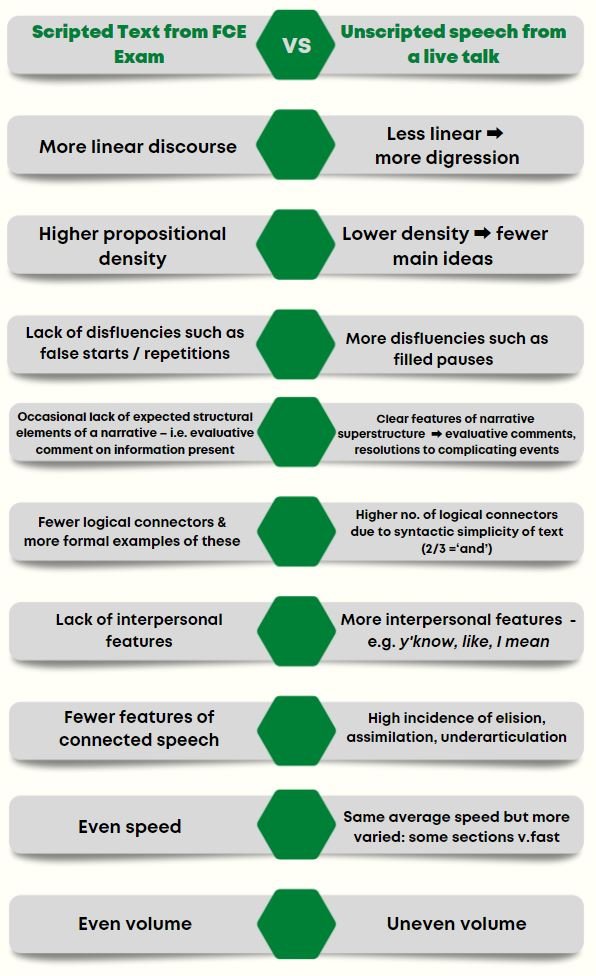Listening issues: Learner difficulties with unscripted speech.
Listening in an additional language poses a major difficulty to language learners. In this post, Shaun Sweeney reports on a small-scale research project investigating what makes authentic speech so difficult for our learners.
This is a brief summary of key findings from a small-scale, mixed methods (quantitative/qualitative) study into differences between scripted and unscripted listening material and the challenges each pose to English language learners. The research was carried out as part of my Master’s thesis in 2019 in Barcelona.
The difference between scripted ELT material and unscripted authentic speech
The study used 2 listening texts matched for genre (photographers giving a public talk about their jobs – how they started out etc.)
Text A (scripted) was from Cambridge First (FCE) past papers.
Text B (unscripted) was from a National Geographic Live event with climber and nature photographer, Jimmy Chin.
Jimmy Chin, Mountaineer and Photographer for National Geographic
Comparison table of the 2 texts used
The study
Participants:
20 Upper Intermediate (B2) level adult language learners in Barcelona. L1 Spanish and/or Catalan.
Simplified procedure:
They listened to 2 different audio recordings, one scripted and one unscripted.
They could take notes if they wanted to.
They then had to report the main facts. The number of main ideas had already been ascertained via text-mapping (Weir, 2005, Green 2017).
This was done orally to maintain the spoken mode throughout.
No questions were given in advance (to avoid giving a ‘gratis’ schema of the text in advance).
Participants were asked to justify their answers and say how confident they were of their answers. They were also encouraged to report their feelings about the two texts and any listening behaviour/strategies used.
Results:
No big surprises - the unscripted, authentic text was more difficult.
Individual performance varied widely but for this sample, the number of correctly reported points was higher for the scripted text. (Not a statistically significant result so broadly indicative only).
The number of incorrect points was higher for the authentic text (Statistically significant result).
All but 1 participant could quickly identify which was the ‘real’ audio and which was scripted.
The texts were analysed for ‘difficult’ main points – i.-e those most often incorrectly reported or omitted. The unscripted text, despite it’s lower number of points, has more of these. Also, despite the wide variance in performance overall on the listening, these points were ‘stubborn’ – they were either incorrect OR omitted. This was not the case with the scripted text - different listeners omitted or incorrectly reported different main ideas. These ‘stubborn’ points in the unscripted text were precisely those points connected to phonological features of connected speech or irregularity of discourse and delivery.
Difficulties with scripted text: propositional density and presence of ‘distractors’. One participant reported confusion due to artificial nature of scripted text - some facts given with no evaluative comment from the speaker.
Difficulties with unscripted text: underarticulation, irregularity of delivery, non-linearity of discourse.
Listen for yourself:
Text B (the Jimmy Chin extract)
[Original video of his talk here.]
So what?
Unscripted spoken texts are noticeably and considerably different in their discourse and delivery from scripted texts. They also present more challenge to inexpert L2 listeners even at the relatively high language level of B2, a requirement for undergraduate study in many English-medium institutions.
If we ignore the challenges of such texts by omitting them from teaching syllabi, we’re doing a disservice to the language learner.
In terms of assessment practice, the backwash effect of preparing students for proficiency tests that use scripted texts means little valuable classtime is left for preparing learners to cope with the realities of authentic input.
L2 listeners do find authentic texts more difficult to process than scripted and that the reasons for misunderstanding in the scripted text in this study were often due to its high propositional density, a feature typical of written discourse and thus not representative of real-world listening conditions.
In contrast, the authentic text caused misunderstandings due to features of irregularity in discourse and delivery. Often these correspond to ‘lower’ perceptual levels of processing (de-coding the sounds).
Following the common advice to ‘just keep practising’ is unlikely to resolve these issues. Instead, a direct approach to teaching the features of authentic, unplanned speech could present a better way forward.



